Technical Aspects and Energy Effects of Waste Heat Recovery from District Heating Boiler Slag
Abstract
:1. Introduction
2. System Description
- high efficient cogeneration unit based on a steam turbine STU supplied with hard coal stoker-fired steam boiler SSCB (labelled as OR50), examined for slag heat recovery,
- one pulverized hard coal-fired water boiler PCB (labelled as WP120) with the nominal heat capacity 125 MW,
- two hard coal stoker-fired water boilers SCB (labelled as WR25 no. 1 and no. 2) with the nominal heat capacity 33 MW each,
- a high-efficiency cogeneration unit based on a gas turbine unit GTU fired with natural gas of a nominal electric capacity 7.4 MW and integrated with a heat recovery boiler HRB of a nominal heat capacity 14.7 MW.
3. Problem Formulation, Methods and Input Data
- —unitary slag volume, kg/kg of coal
- —coefficient of ash contraction in coal, assumed as 0.9
- —ash content in coal, wt.%
- —total organic carbon of slag-ash mixture, wt.%
- —enthalpy flux of the slag, kW
- —physical enthalpy flux of the slag, kW
- —chemical enthalpy flux of the slag, kW
- —slag flux, kg/s
- —specific physical enthalpy of the slag, kJ/kg
- —slag temperature, °C.
- —heat flux available for recovery, kW
- —physical enthalpy flux of the slag, kW
- —physical enthalpy of the slag leaving deslagger, kW
- —physical enthalpy of the water lost with the slag, kW
- —heat energy losses, kW, assumed as 2% of
- —physical enthalpy of the refill water, kW
4. Results and Discussion
5. Proposal of Technical Solution for Slag Energy Recovery
- direct heat recovery in the existing slag trap,
- first proposal extended by installing a worm conveyor tube covered by a heat exchanger coil.
5.1. Energy Performance of the Slag Waste Heat Recovery System
5.2. Energy Performance of the Waste Heat Recovery System
- annual operation time of the heat pump: = 3115 h,
- heat recovered from the deslagger: = 1,700,600 kWh (6122 GJ),
- heat supplied into the return pipe of district heating system: = 2,270,582 kWh (8174 GJ),
- electricity consumed by the heat pump: = 616,390 kWh.
5.3. Economic Evaluation
- price of heat generated in the analyzed plant: = 6 €/GJ,
- electricity price consumed by the heat pump: = 50 €/MWh.
6. Conclusions
- High temperature of the slag generated in the boiler can be a challenge for developing heat recovery system.
- Waste energy potential of the slag produced in stoker-boilers fired with hard coal has relatively low share in boiler energy balance.
- Recovering the heat from the slag not only improves the energy efficiency of the district heating system but, due to the reduction of the temperature of water in the slag tub, limits the tribocorrosion phenomena in the deslagger.
- Applying a heat pump for energy recovery from the slag can be more feasible if electricity is available onsite from a production facility (cogeneration units in the analyzed case).
- The proposal of heat recovery systems from low temperature slag is a technical and economic challenge but can be an economically justified solution in certain circumstances.
- Slag energy recovery facilities should be applied in line with old traps replacement to improve economic feasibility of the recovery.
Acknowledgments
Author Contributions
Conflicts of Interest
Abbreviations
| coefficient of ash contraction in coal | |
| ash content in coal, wt.% | |
| specific heat of the slag, kJ/kgK | |
| electricity consumption of the heat pump, kWh | |
| slag flux, kg/s | |
| specific physical enthalpy of the slag, kJ/kg | |
| chemical enthalpy flux of the slag, kW | |
| physical enthalpy of the water lost with the slag, kW | |
| physical enthalpy of the slag leaving deslagger, kW | |
| physical enthalpy of the refill water, kW | |
| physical enthalpy flux of the slag, kW | |
| enthalpy flux of the slag, kW | |
| k | thermal conductivity, W/mK |
| electric power output of cogeneration units, kW | |
| hot water nominal pressure, MPa | |
| output capacity distribution of the boiler, MW | |
| annual quantity of waste energy supplied to the district heating DH system, GJ | |
| annual quantity of waste energy recovered from the slag, GJ | |
| heat flux available for recovery, kW | |
| heat energy losses, kW | |
| annual quantity of waste energy in the slag, GJ | |
| waste energy flux, kW | |
| heating capacity, kW | |
| unitary slag volume, kg/kg of coal | |
| time, h | |
| annual operation time of heat pump, h | |
| total organic carbon, % | |
| total organic carbon of slag-ash mixture, wt.% | |
| temperature of DH return water, °C | |
| slag temperature, °C | |
| nominal (maximum) supply temperature, °C | |
| water temperature in the deslagger tub, °C | |
| CHE | condenser heat exchange unit |
| DH | district heating |
| GTU | gas turbine unit |
| HE | heat exchanger |
| HP | heat pump |
| HRB | heat recovery boiler |
| PCB | pulverized hard coal-fired water boiler |
| SCB | stocker coal boiler |
| SPB | simple payback time |
| SSCB | hard coal stoker-fired steam boiler |
| STU | steam turbine unit |
References
- Rose, L. (Ed.) Energy: Modern Energy Storage, Conversion, and Transmission in the 21st Century; Nova Science Publishers, Inc.: New York, NY, USA, 2013. [Google Scholar]
- Klemeš, J.J. (Ed.) Assessingand Measuring Environmental Impact and Sustainability; Butterworth-Heinemann: Oxford, UK, 2015. [Google Scholar]
- Duić, N.; Rosen, M.A. Sustainable development of energy systems. Energy Convers. Manag. 2014, 87, 1057–1062. [Google Scholar] [CrossRef]
- Sadek, D.M. Effect of cooling technique of blast furnace slag on the thermal behavior of solid cement bricks. J. Clean. Prod. 2014, 79, 134–141. [Google Scholar] [CrossRef]
- Wzorek, M.; Kozioł, M.; Ścierski, W. Emission characteristics of granulated fuel produced from sewage sludge and coal slime. J. Air Waste Manag. Assoc. 2010, 60, 1487–1493. [Google Scholar] [CrossRef] [PubMed]
- Stijepovic, M.Z.; Linke, P. Optimal waste heat recovery and reuse in industrial zones. Energy 2011, 36, 4019–4031. [Google Scholar]
- Chae, S.H.; Kim, S.H.; Yoon, S.G.; Park, S. Optimization of a waste heat utilization network in an eco-industrial park. Appl. Energy 2010, 87, 1978–1988. [Google Scholar] [CrossRef]
- Nemet, A.; Klemeš, J.J.; Kravanja, Z. Optimising entire lifetime economy of heat exchanger networks. Energy 2013, 57, 222–235. [Google Scholar] [CrossRef]
- Ma, G.Y.; Cai, J.J.; Zeng, W.W.; Dong, H. Analytical research on waste heat recovery and utilization of China’s iron & steel industry. Energy Procedia 2012, 14, 1022–1028. [Google Scholar]
- Szargut, J.; Ziębik, A.; Kozioł, J.; Kurpisz, K.; Majza, E. Industrial Waste Energy; WNT: Warsaw, Poland, 1993; (In Polish). ISBN 83-204-1626-4. [Google Scholar]
- Barati, M.; Esfahani, S.; Utigard, T.A. Energy recovery from high temperature slags. Energy 2011, 36, 5440–5449. [Google Scholar] [CrossRef]
- Bisio, G. Energy recovery from molten slag and exploitation of the recovered energy. Energy 1997, 22, 501–509. [Google Scholar] [CrossRef]
- Mills, K.C. Heat Transfer and Thermal Conductivity of Coal Slags. In Mineral Matter and Ash in Coal; ACS Symposium Series 301; Vorres, K.S., Ed.; American Chemical Society: Washington, DC, USA, 1986; pp. 256–276. [Google Scholar]
- Rezaei, H.R.; Gupta, R.P.; Bryant, G.W.; Hart, J.T.; Liu, G.S.; Bailey, C.W.; Wall, T.F.; Miyamae, S.; Makino, K.K.; Endo, Y. Thermal conductivity of coal ash and slags and models used. Fuel 2000, 79, 1697–1710. [Google Scholar] [CrossRef]
- Henry, P.; Takadoum, J.; Berçot, P. Tribocorrosion of 316L stainless steel and TA6V4 alloy in H2SO4 media. Corros. Sci. 2009, 51, 1308–1314. [Google Scholar] [CrossRef]
- Jiang, J.; Stack, M.M.; Neville, A. Modelling the tribo-corrosion interaction in aqueous sliding conditions. Tribol. Int. 2002, 35, 669–679. [Google Scholar] [CrossRef]
- Mischler, S. Triboelectrochemical techniques and interpretation methods in tribocorrosion: A comparative evaluation. Tribol. Int. 2008, 41, 573–583. [Google Scholar] [CrossRef]
- Mi, X.; Cai, Z.B.; Xiong, X.M.; Qian, H.; Tang, L.C.; Xie, Y.C.; Peng, J.F.; Zhu, M.H. Investigation on fretting wear behavior of 690 alloy in water under various temperatures. Tribol. Int. 2016, 100, 400–409. [Google Scholar] [CrossRef]
- Diomidis, N.; Mischler, S. Third body effects on friction and wear during fretting of steel contacts. Tribol. Int. 2011, 44, 1452–1460. [Google Scholar] [CrossRef]
- Hasan, B.O.; Sadek, S.A. The effect of temperature and hydrodynamics on carbon steel corrosion and its inhibition in oxygenated acid–salt solution. J. Ind. Eng. Chem. 2014, 20, 297–307. [Google Scholar] [CrossRef]
- Wang, Z.H.; Lu, Y.H.; Li, J.; Shoji, T. Effect of pH value on the fretting wear behavior of Inconel 690 alloy. Tribol. Int. 2016, 95, 162–169. [Google Scholar] [CrossRef]
- López-Ortega, A.; Bayón, R.; Arana, J.L.; Arredondo, A.; Igartua, A. Influence of temperature on the corrosion and tribocorrosion behaviour of High-Strength Low-Alloy steels used in offshore applications. Tribol. Int. 2018, in press. [Google Scholar]
- Sun, Y.; Shen, H.; Wang, H.; Wang, X.; Zhang, Z. Experimental investigation and modeling of cooling processes of high temperature slags. Energy 2014, 76, 761–767. [Google Scholar] [CrossRef]
- Trashorras, A.J.G.; Álvarez, E.Á.; González, J.L.R.; Cuesta, J.M.S.; Bernat, J.X. Design and evaluation of a heat recuperator for steel slags. Appl. Therm. Eng. 2013, 56, 11–17. [Google Scholar] [CrossRef]
- Ortega-Fernández, I.; Calvet, N.; Gil, A.; Rodríguez-Aseguinolaza, J.; Faik, A.; D’Aguanno, B. Thermophysical characterization of a by-product from the steel industry to be used as a sustainable and low-cost thermal energy storage material. Energy 2015, 89, 601–609. [Google Scholar] [CrossRef]
- Zhang, H.; Wang, H.; Zhu, X.; Qiu, Y.J.; Li, K.; Chen, R.; Liao, Q. A review of waste heat recovery technologies towards molten slag in steel industry. Appl. Energy 2013, 112, 956–966. [Google Scholar] [CrossRef]
- Mills, K.C. Estimation of physicochemical properties of coal slags. In Mineral Matter and Ash in Coal; ACS Symposium Series 301; Vorres, K.S., Ed.; American Chemical Society: Washington, DC, USA, 1986; pp. 195–214. [Google Scholar]
- Yu, X.; Zhang, Y.; Kong, L.; Zhang, Y. Thermodynamic analysis and parameter estimation of a high-temperature industrial heat pump using a new binary mixture. Appl. Therm. Eng. 2018, 131, 715–723. [Google Scholar] [CrossRef]
- Wu, X.; Xing, Z.; He, Z.; Wang, X.; Chen, W. Performance evaluation of a capacity-regulated high temperature heat pump for waste heat recovery in dyeing industry. Appl. Therm. Eng. 2016, 93, 1193–1201. [Google Scholar] [CrossRef]
- Xiaohui, Y.; Yufeng, Z.; Na, D.; Chengmin, C.; Yan, Z. Experimental performance of high temperature heat pump with near-azeotropic refrigerant mixture. Energy Build. 2014, 78, 43–49. [Google Scholar] [CrossRef]
- Zhang, Y.; Zhang, Y.; Yu, X.; Guo, J.; Deng, N.; Dong, S.; He, Z.; Ma, X. Analysis of a high temperature heat pump using BY-5 as refrigerant. Appl. Therm. Eng. 2017, 127, 1461–1468. [Google Scholar] [CrossRef]
- Chamoun, M.; Rulliere, R.; Haberschill, P.; Peureux, J.L. Experimental and numerical investigations of a new high temperature heat pump for industrial heat recovery using water as refrigerant. Int. J. Refrig. 2014, 44, 177–188. [Google Scholar] [CrossRef]
- Tańczuk, M.; Skorek, J.; Bargiel, P. Energy and economic optimization of the repowering of coal-fired municipal district heating source by a gas turbine. Energy Convers. Manag. 2017, 149, 885–895. [Google Scholar] [CrossRef]

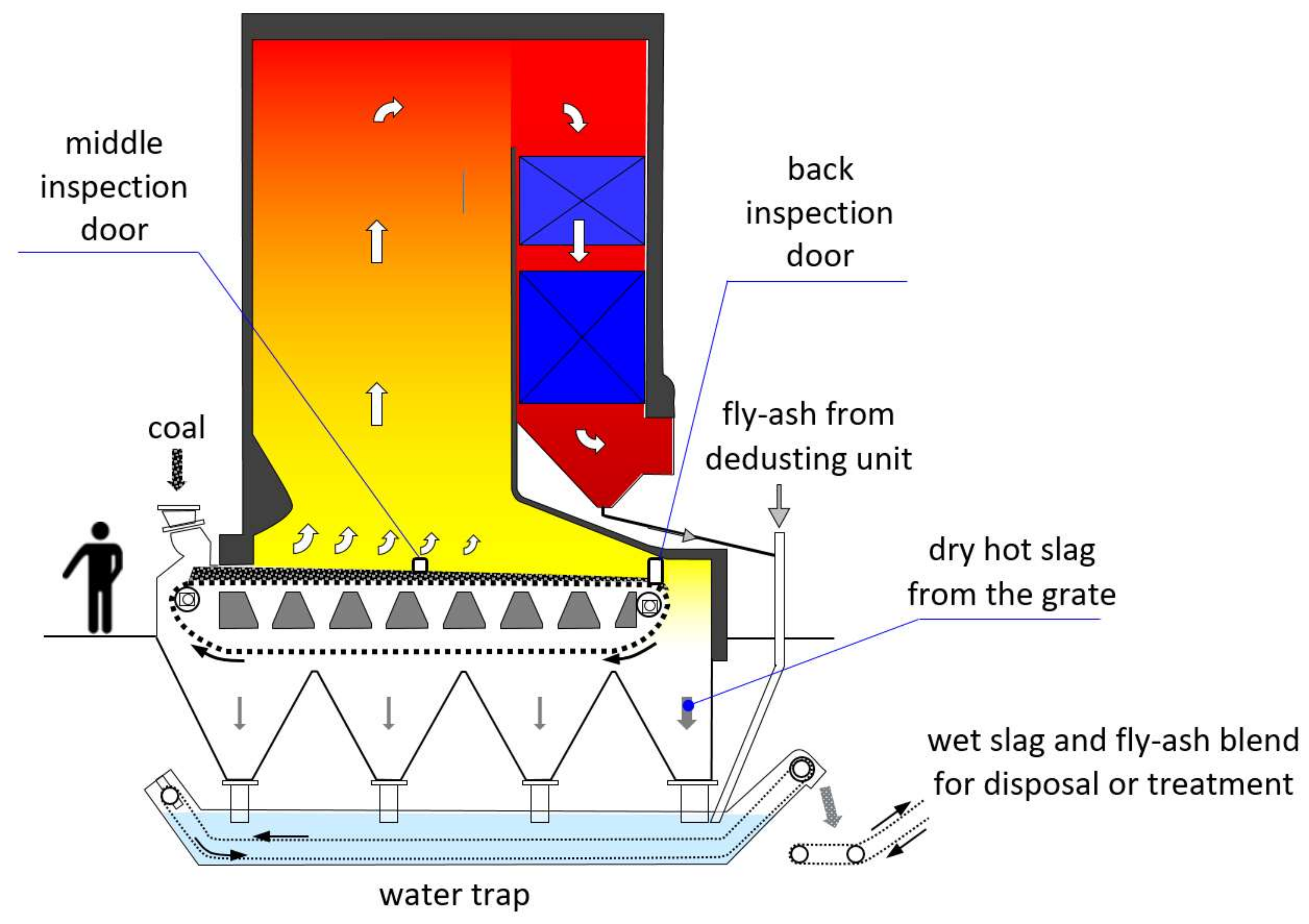


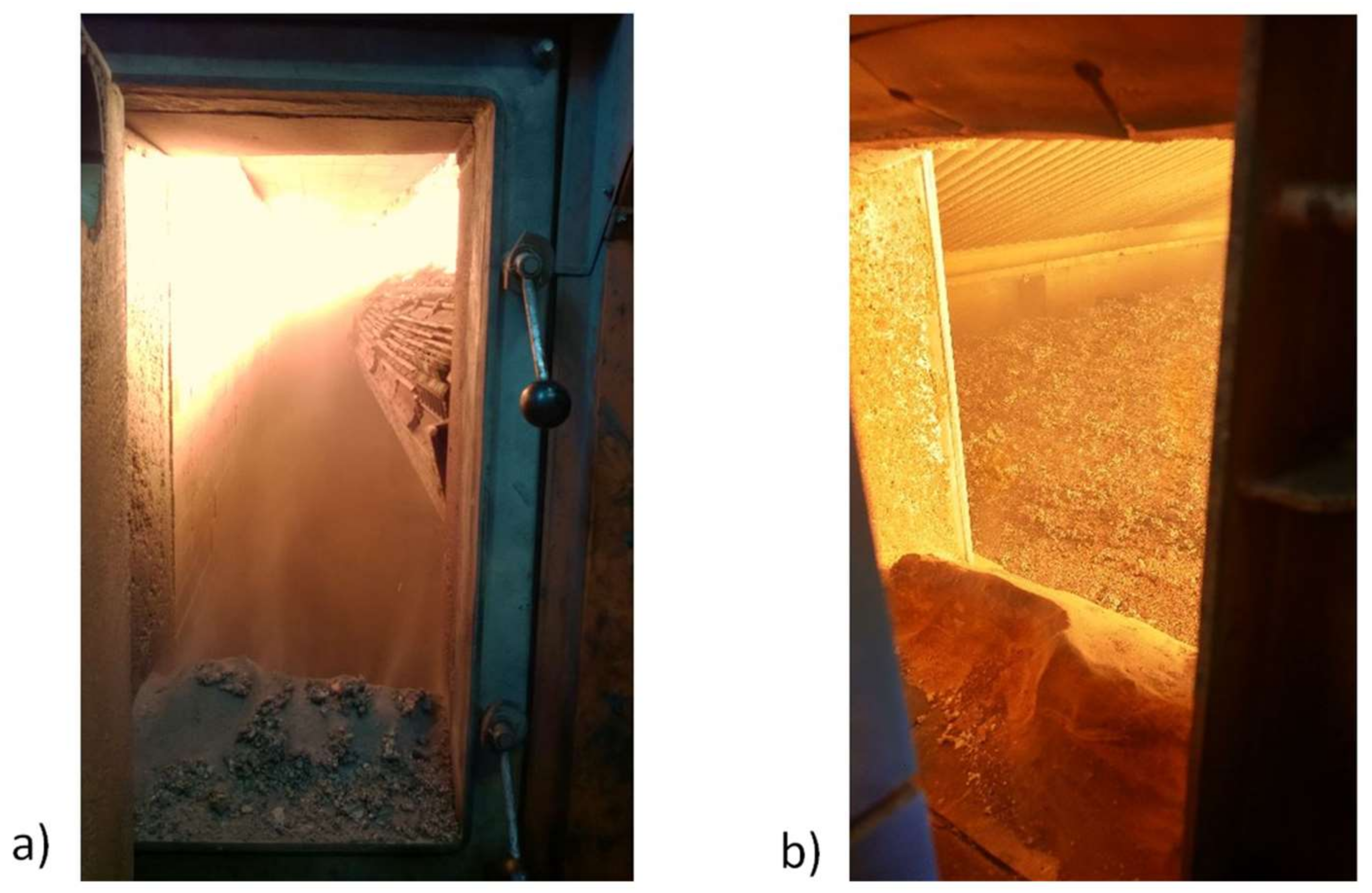


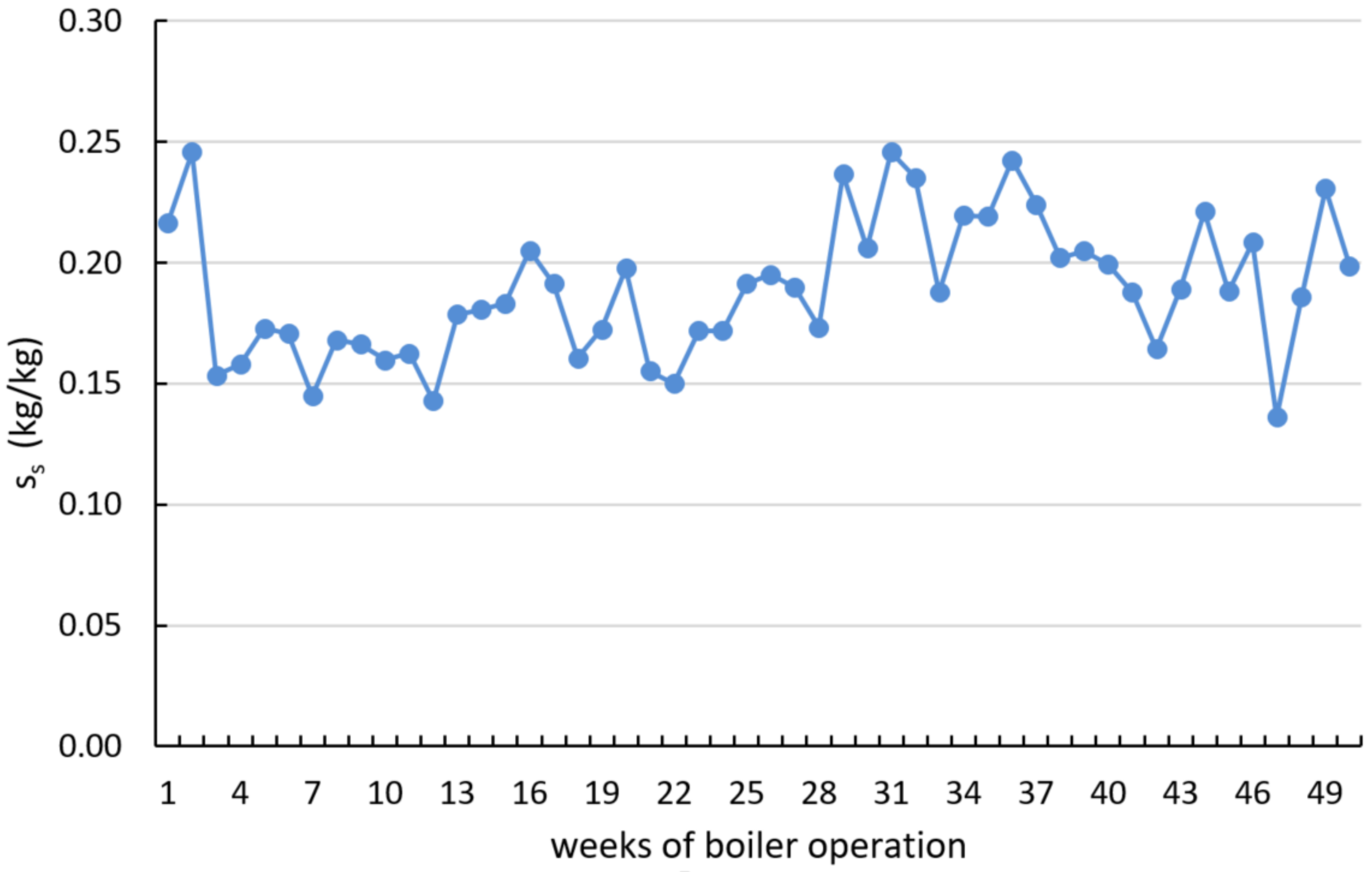
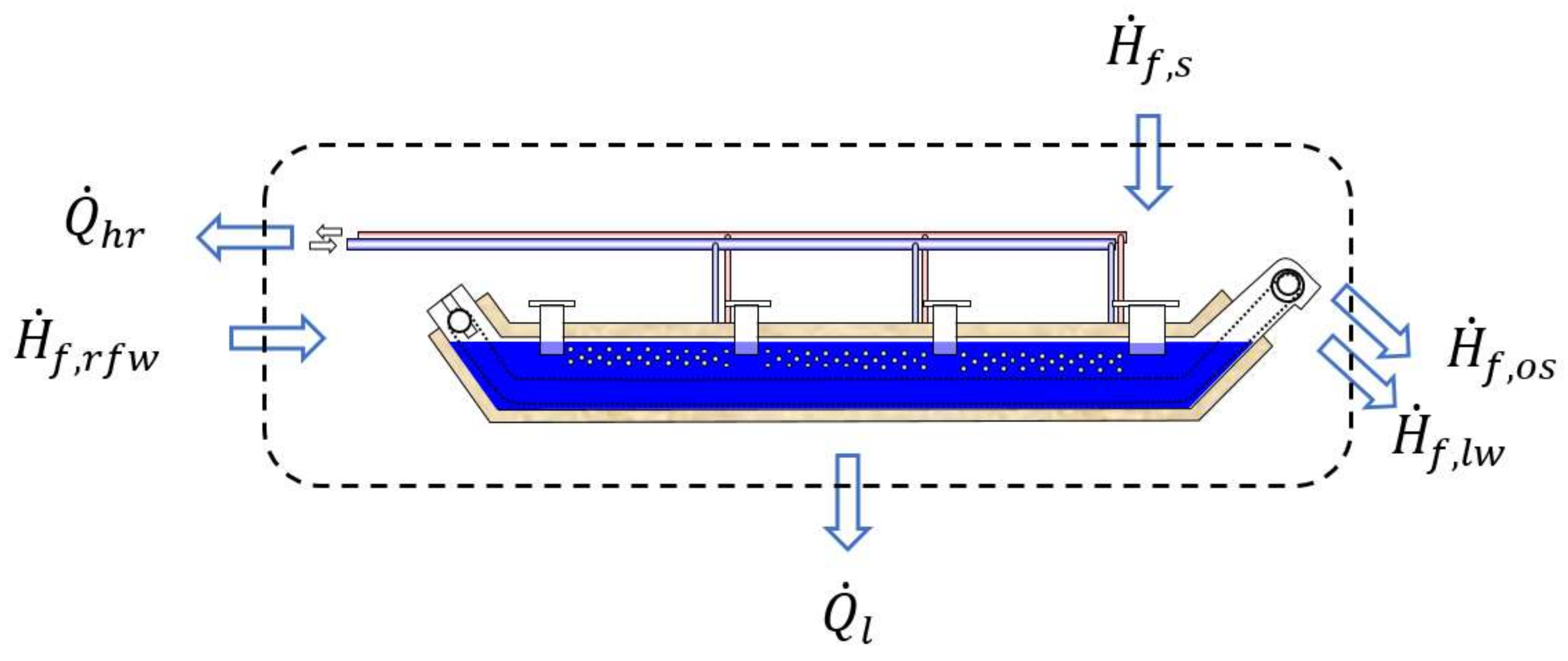
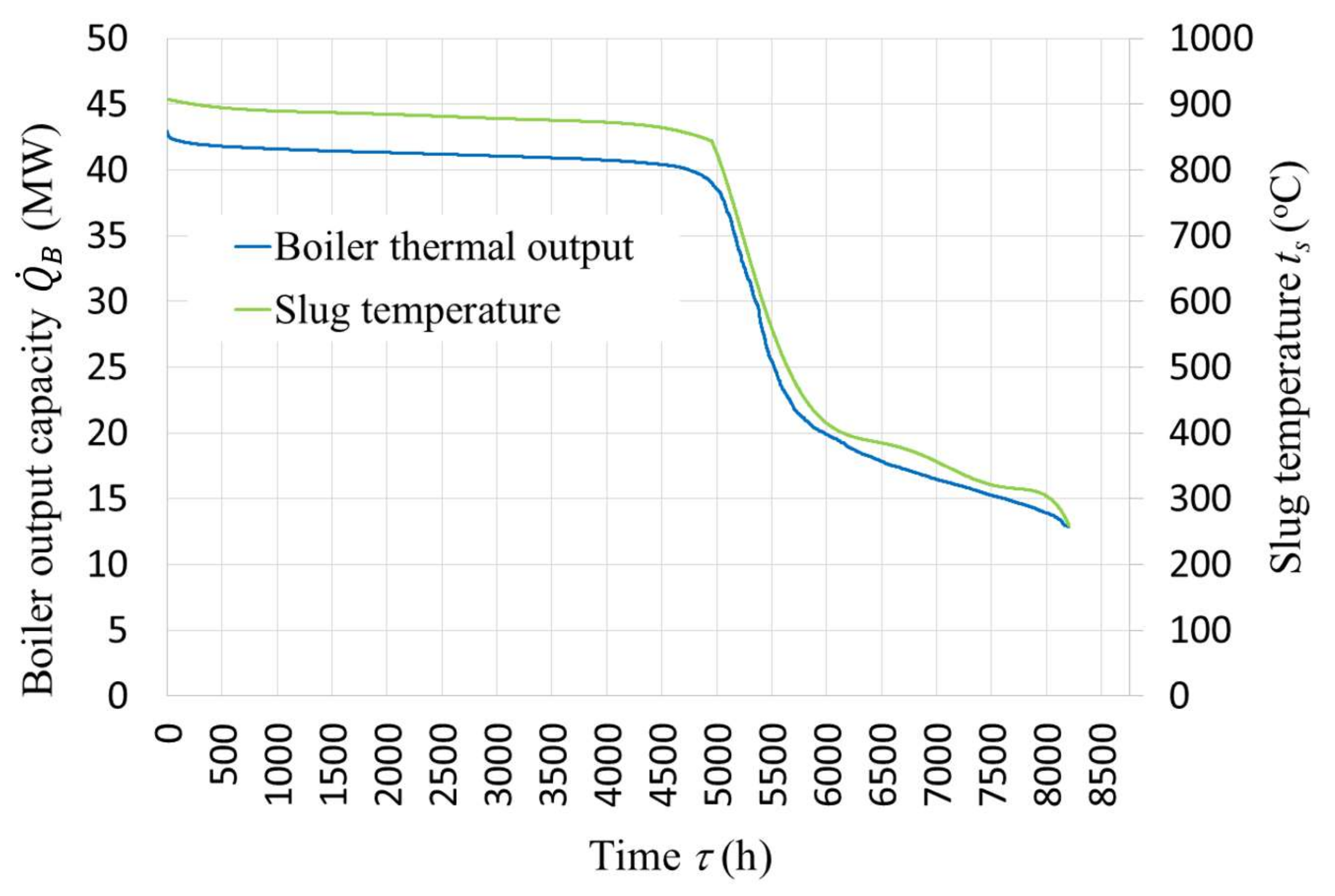
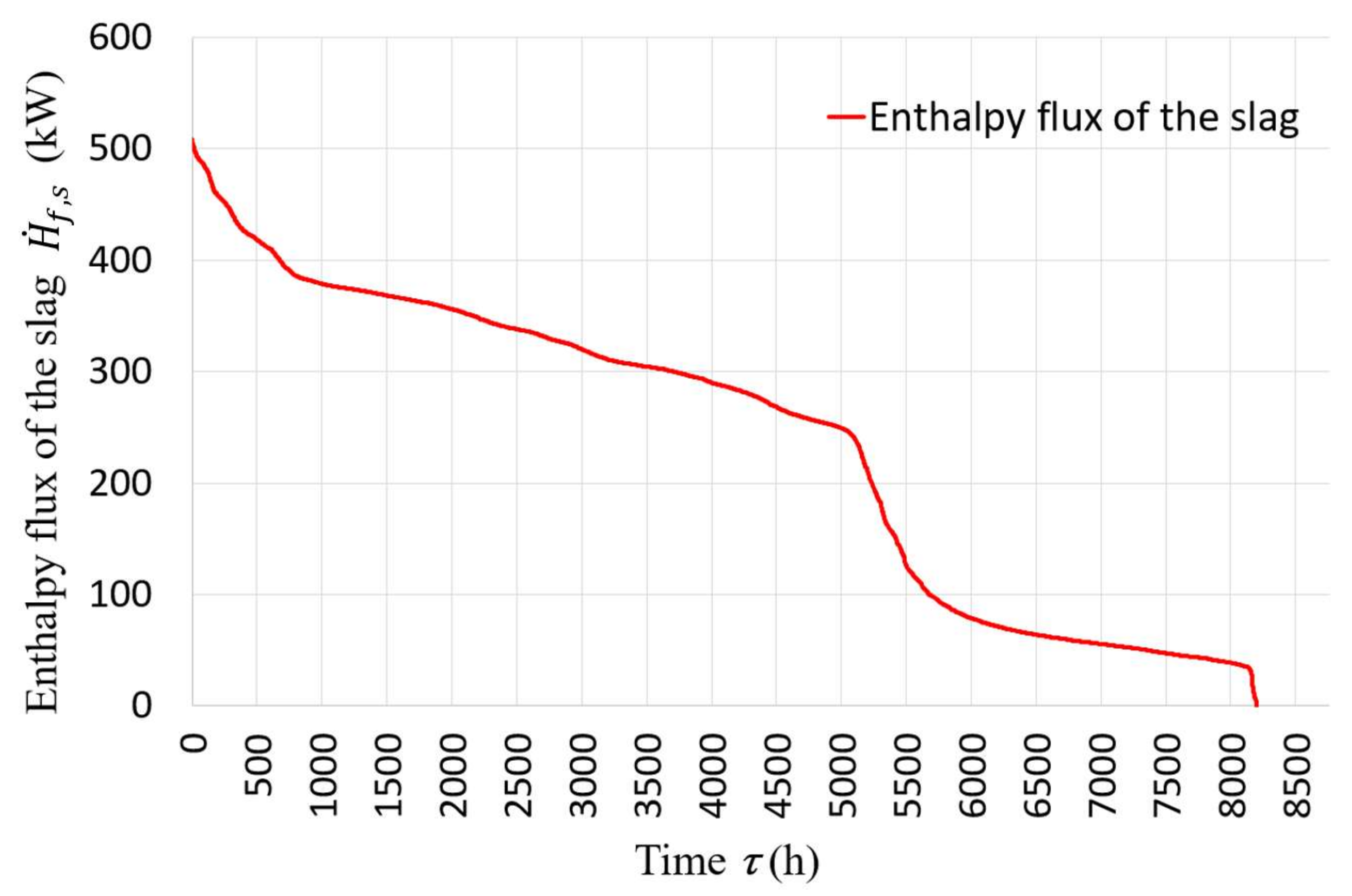

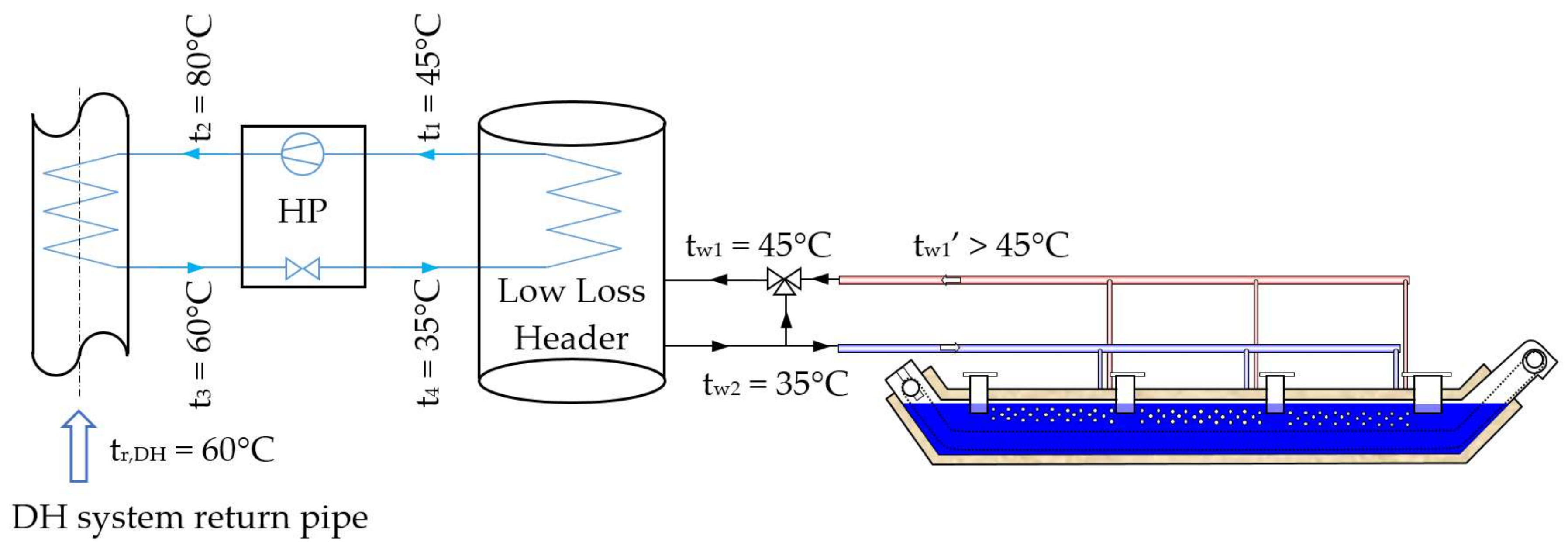




| No. | Property | Unit | Value * | Testing Standard |
|---|---|---|---|---|
| 1 | Moisture content | wt.% | 10.5 | PN—80/G-04511 |
| 2 | Ash content | wt.% | 14.9 | Accredited testing procedure |
| 3 | Carbon content | wt.% | 62.83 | PN-G-04571:1998 |
| 4 | Hydrogen content | wt.% | 3.31 | ISO/TS 12902:2007 |
| 5 | Nitrogen content | wt.% | 1.10 | ISO/TS 12902:2007 |
| 6 | Sulphur content | wt.% | 0.40 | PN-ISO 351:1999 |
| 7 | Lower Heating Value | MJ kg−1 | 23.668 | Calculated |
| 8 | Higher Heating Value | MJ kg−1 | 27.185 | PN-81/G-04513 |
| No. | Property | Unit | Value * | Testing Standard |
|---|---|---|---|---|
| 1 | Moisture content | wt.% | 31.0 | Accredited testing procedure |
| 2 | TOC | wt.% | 23.33 | Accredited testing procedure |
| 3 | Carbon content | wt.% | 15.3 | Accredited testing procedure |
| 4 | Size distribution: | wt.% | - | - |
| 4a | >10 | wt.% | 45.8 | - |
| 4b | 10 ÷ 5 | wt.% | 17.6 | - |
| 4c | 5 ÷ 3 | wt.% | 8.7 | - |
| 4d | 3 ÷ 1 | wt.% | 13.6 | - |
| 4e | 1 ÷ 0.5 | wt.% | 6.2 | - |
| 4f | <0.5 | wt.% | 8.1 | - |
| Performance Information | Value |
|---|---|
| Heating capacity | 729 kW |
| Heating efficiency (coefficient of performance—COP) * | 3.69 kW/kW |
| Cooling capacity | 546 kW |
| Unit power input | 198 kW |
| Leaving temperature (evaporator) | 35 °C |
| Supply temperature (evaporator) | 45 °C |
| Leaving temperature (condenser) | 80 °C |
| Supply temperature (condenser) | 60 °C |
| Parameter | Value |
|---|---|
| Total investment cost | 130,000 € |
| Annual incomes | 49,044 € |
| Annual costs | 30,820 € |
| Simple payback time SPB | 7.1 years |
© 2018 by the authors. Licensee MDPI, Basel, Switzerland. This article is an open access article distributed under the terms and conditions of the Creative Commons Attribution (CC BY) license (http://creativecommons.org/licenses/by/4.0/).
Share and Cite
Tańczuk, M.; Masiukiewicz, M.; Anweiler, S.; Junga, R. Technical Aspects and Energy Effects of Waste Heat Recovery from District Heating Boiler Slag. Energies 2018, 11, 796. https://doi.org/10.3390/en11040796
Tańczuk M, Masiukiewicz M, Anweiler S, Junga R. Technical Aspects and Energy Effects of Waste Heat Recovery from District Heating Boiler Slag. Energies. 2018; 11(4):796. https://doi.org/10.3390/en11040796
Chicago/Turabian StyleTańczuk, Mariusz, Maciej Masiukiewicz, Stanisław Anweiler, and Robert Junga. 2018. "Technical Aspects and Energy Effects of Waste Heat Recovery from District Heating Boiler Slag" Energies 11, no. 4: 796. https://doi.org/10.3390/en11040796






